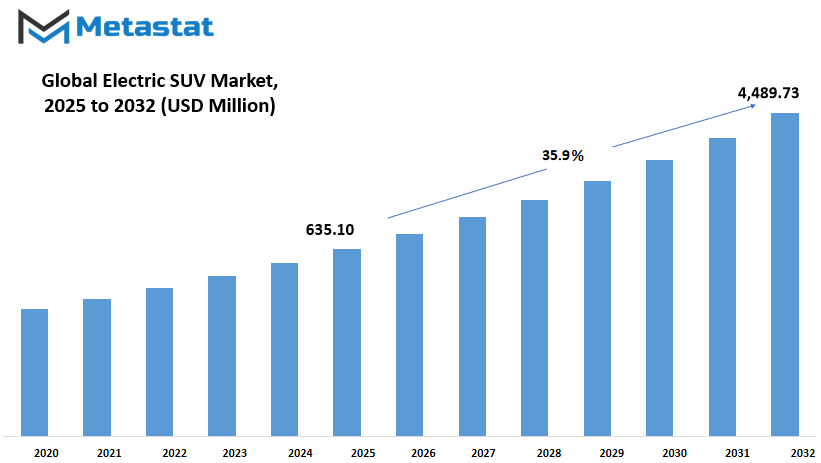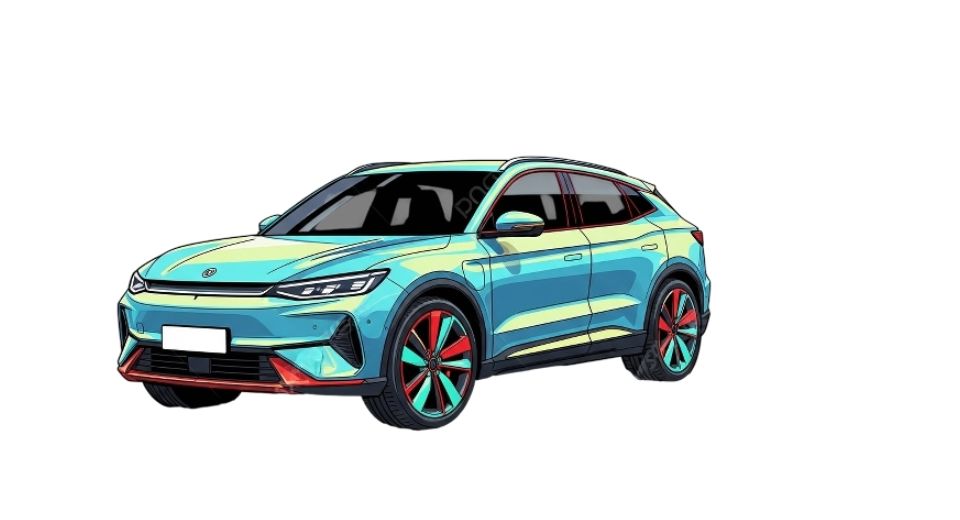MARKET OVERVIEW
The global electric suv market is a singular aspect of the wider electric vehicle marketplace, one which will redefine how the motor industry conceptualizes utility, performance, and sustainability. As governments drive the agenda for stricter emissions rules and urban-based consumers seek alternatives to traditional combustion-driven engines, this marketplace will steadily evolve in new and in some cases unexpected ways. Where it sits at the intersection of clean mobility and sport utility demand, the market is unique in that it mingles technical innovation, localization, and shifting consumer demand in a unique manner.
Electric SUVs are no longer a niche product or outlier experiment. They will shift from being status symbols or technology-driven fads to mass market offerings for families, professionals, and outdoor enthusiasts. This shift will not occur alone. It will happen on continents, where charging equipment, public policy, and manufacturing potential will all have their influence together in directing market behavior. But apart from logistics and technology, what will drive this category is how much it will be aligned to a changing lifestyle that demands performance alongside accountability. Various challenges will face electric SUVs from other car segments.
Their design must balance the larger body weight with battery capacity without sacrificing range. Automakers must re-engineer platform architecture, ensuring that weight, torque transmission, and battery thermal management coexist harmoniously. This will make many brands wager heavily on purpose-built electric SUV platforms rather than converting existing internal combustion engine models. The result will be a generation of vehicles that are engineered from the ground up, not simply styled to fit demand. This market will also present with unique regional variation. For instance, the priorities in North America space, towing, ruggedness are different from Europe or East Asia, where efficiency in urban environments and compactness are the preferences. These regional variations will push manufacturers to diversify their product strategies while, simultaneously, heading towards global supply chains and common tech standards.
It's important to understand that the global electric suv market isn't going to transform merely on the basis of policy rules or corporate strategy. Cultural empathy will be required. There are individuals who still equate SUVs with gas-guzzling excess in parts of the world. If electric SUVs are to break past that, then manufacturers will have to create vehicles that sport both ecological sensitivity and dramatic good looks usually found in SUVs. This balance will be painstaking to learn, but will be essential to mass adoption. Competition in this segment will only intensify in the future. Established automakers as well as new ones will battle for market share as well as trust. Customers will expect proof of performance, reliability, and durability over the long term. The winners will not only make the best electric SUVs they will make ecosystems out of them, including services, software updates, and embedded driving experiences.
The global electric suv market, therefore, will not only bring in a new chapter to the history of cars it will write a new page. And when the next generation of cars begins to roll out of factories, not only will they have human beings inside but also the weight of expectations that this part of the market will be designed to deliver.
Global electric suv market is estimated to reach $4,489.73 Million by 2032; growing at a CAGR of 35.9% from 2025 to 2032.

GROWTH FACTORS
The global electric suv market is expected to grow steadily over the next several years. This growth will be mainly driven by rising environmental concerns and strong government support for electric vehicle. As more people become aware of climate change and its impact, the demand for cleaner transport options will increase. Many countries are offering tax benefits, incentives, and building charging infrastructure to encourage the switch from fuel-powered vehicles to electric alternatives. This kind of support helps both manufacturers and buyers, making electric SUVs a more accessible choice.
Another important factor driving the global electric suv market is the improvement in battery technology. Batteries are becoming more efficient, lasting longer, and charging faster. This helps reduce concerns over limited driving range and long charging times, two things that have held back buyers in the past. At the same time, more companies are entering the electric SUV segment. This competition is bringing better designs, wider choices, and lower prices, which attract more customers.
However, there are still a few things that might slow down the market’s progress. One major issue is the high upfront cost of electric SUVs. Even though prices are dropping, many models are still more expensive than traditional ones. Not everyone can afford them, even with government help. Another challenge is the limited number of charging stations in some areas, especially in developing countries. Without easy access to charging points, people may hesitate to buy electric vehicles.
On the brighter side, new trends and technologies could create good opportunities for the global electric suv market in the years to come. Self-driving features and smart technology inside vehicles will appeal to a younger audience that values both convenience and innovation. Also, as clean energy sources like solar and wind become more common, using electricity to power cars will become even more eco-friendly. This could encourage more people to make the switch.
In the future, as production methods improve and raw material costs come down, electric SUVs will likely become more affordable for everyone. Manufacturers are also likely to expand their offerings to suit different needs, from compact models for city driving to larger ones for families. These changes, along with growing public interest and government backing, point to a promising future for the global electric suv market. While there may be bumps along the way, the overall direction remains positive and filled with possibility.
MARKET SEGMENTATION
By Propulsion Type
The global electric suv market is showing steady growth and will likely expand even more in the future. As more countries push for cleaner energy solutions and aim to reduce harmful emissions, electric SUVs are becoming a practical choice for drivers. These vehicles blend the size and comfort of traditional SUVs with the benefits of electric power. They are not only more efficient but also quieter and cheaper to maintain over time. Government support through tax benefits and infrastructure development is making it easier for people to consider electric options. Charging stations are popping up in more places, and battery technology continues to improve, helping ease common concerns like range anxiety.
Looking ahead, the global electric suv market will continue to change as technology advances. One of the biggest parts of this market is the division by propulsion type, which includes Battery Electric Vehicles (BEVs) and Plug-in Hybrid Electric Vehicles (PHEVs). BEVs run completely on electricity and are ideal for those who want to fully move away from gas-powered cars. As batteries become more powerful and affordable, BEVs will likely lead the charge in most areas. They offer zero tailpipe emissions, which appeals to both buyers and policymakers focused on long-term sustainability.
On the other hand, PHEVs have a mix of both electric power and a fuel engine, giving drivers the flexibility to switch between the two. This option works well for those who still need the backup of a fuel engine, especially in regions where charging stations are still limited. In the coming years, improvements in charging speed and hybrid efficiency will likely make PHEVs even more attractive to a wide group of drivers.
Another factor pushing this market forward is consumer demand for smarter, connected vehicles. Electric SUVs often come equipped with the latest features like advanced driver assistance systems, voice control, and app-based controls. These additions are no longer seen as luxury options but as standard expectations. Car makers are responding by producing a broader range of models to match different lifestyles and budgets.
Overall, the future of the global electric suv market looks promising. As new propulsion systems become more common and cities become more supportive of electric transport, both BEVs and PHEVs will play important roles in shaping tomorrow’s roads. The shift is not just a trend but a lasting move toward cleaner, smarter, and more reliable driving experiences.
By Vehicle Type
The global electric suv market is expected to grow steadily over the coming years as more people choose environmentally friendly vehicles. As governments introduce stricter rules on emissions and offer incentives for clean energy transport, electric SUVs are becoming a more common choice among buyers. This shift isn’t just about reducing pollution; it’s also about providing drivers with better technology, improved performance, and lower long-term costs. People today are not only looking for functionality but also for vehicles that match their lifestyle, and electric SUVs are meeting that need in more ways than one.
Manufacturers around the world are making big moves to keep up with the rising demand. They are working on more affordable models and increasing the range of electric SUVs to remove one of the major concerns buyers often have how far the vehicle can travel on a single charge. Charging infrastructure is also improving in many countries, which makes owning an electric vehicle more convenient than it used to be. As battery technology continues to improve, drivers will likely spend less time waiting for a full charge and more time on the road.
Looking ahead, the global electric suv market will be shaped by advancements in automation, connectivity, and energy storage. These vehicles are expected to become smarter, safer, and even more efficient. Over-the-air software updates will let owners receive new features without visiting a dealership, and energy-efficient driving systems will make longer journeys possible without compromising performance. Companies are investing heavily in research and development to lead in this growing market.
By vehicle type, the market includes compact, mid-size, and full-size SUVs. Compact models are gaining popularity in cities because they are easier to park and maneuver. Mid-size options are favored by families looking for a balance between space and cost. Full-size electric SUVs are being developed with luxury and performance in mind, and they appeal to those who want space without giving up on speed or comfort. As technology costs go down and production methods improve, all three categories are likely to become more accessible to everyday buyers.
In the future, owning an electric SUV won’t be seen as a luxury or trend it will be the norm. The choices will be wider, the costs more reasonable, and the benefits clearer to all. This shift will not only support a cleaner planet but also provide a better driving experience for people everywhere.
By Vehicle Range
The global electric suv market is growing steadily and is expected to see major changes in the coming years. As more people turn to electric vehicles for their daily needs, electric SUVs are gaining attention for their blend of space, comfort, and cleaner energy use. The rising concern for environmental issues and stricter rules on emissions are pushing companies to offer more electric options. As a result, the demand for electric SUVs is rising across different parts of the world, and this trend shows no signs of slowing down.
One of the important ways to look at the global electric suv market is by dividing it based on how far these vehicles can go on a single charge. There are three main groups those that can travel up to 250 miles, those in the 250 to 500 miles range, and those that go above 500 miles. Vehicles in the first group, with a range up to 250 miles, are mostly preferred for city use. These are usually more affordable and ideal for people who don’t drive long distances every day. As battery technology improves, even the lower range options are becoming more efficient and practical for short commutes.
The second group, with a range between 250 and 500 miles, is becoming more popular with buyers who want a mix of value and performance. These vehicles can handle both city drives and longer trips, making them a solid choice for families and individuals alike. Car makers are focusing on this range to meet the needs of people who want one vehicle for both workdays and weekends.
The third group, made up of electric SUVs that can travel more than 500 miles on one charge, shows what the future might look like. Though they are often priced higher today, these long-range vehicles will likely become more common as technology becomes more affordable and easier to produce. In the future, these SUVs will allow people to drive long distances without worrying about finding charging stations often.
As the global electric suv market grows, we will see more choices for all types of drivers. The improvements in battery life and charging speed will lead to more trust in electric vehicles. This shift will not only change how people drive but also how cities plan transportation and energy use. What we see today is just the beginning of a wider change in the auto world.
By Drive Type
The global electric suv market is slowly shaping the future of personal transportation. As the world moves towards cleaner energy sources, electric vehicles are becoming more popular among buyers. Within this space, electric SUVs are gaining attention for their ability to combine comfort, size, and eco-friendly performance. With rising awareness about climate change and supportive policies from governments around the world, people are beginning to accept electric vehicles not just as an alternative, but as a better choice. The push for zero-emission vehicles has created a shift in how car makers think and how buyers decide.
One of the key changes happening in this market is how electric SUVs are being built and how they perform. By drive type, the global electric suv market is split into front-wheel drive (FWD), rear-wheel drive (RWD), and all-wheel drive (AWD). Each of these brings something different to the table. FWD models are usually more affordable and are often the first choice for daily urban driving. They’re easier to handle and more energy-efficient on city roads. RWD models are seen in performance-focused SUVs. They offer better balance and control, especially at higher speeds. AWD models, on the other hand, are designed for more demanding conditions, giving drivers better traction on rough roads and during poor weather. These options let buyers pick what suits their needs and surroundings best.
Looking ahead, the future of the global electric suv market seems promising. Advances in battery technology, including faster charging and longer ranges, will improve the appeal of these vehicles. Companies are also working on making their cars smarter, with better software and more driver assistance features. As more charging stations are built and energy sources become greener, people will feel more comfortable choosing electric SUVs. Car manufacturers are expected to offer more models, with a range of prices and features, making electric SUVs more available to different types of buyers.
Even though there are still a few barriers like cost and access to charging in some places, these are being worked on quickly. With strong investment in research and support from government policies, the market is likely to expand steadily. In a few years, it won’t be surprising if electric SUVs become the new standard. The global electric suv market will continue to grow as people choose cleaner, smarter ways to travel.
|
Forecast Period |
2025-2032 |
|
Market Size in 2025 |
$635.10 million |
|
Market Size by 2032 |
$4,489.73 Million |
|
Growth Rate from 2025 to 2032 |
35.9% |
|
Base Year |
2024 |
|
Regions Covered |
North America, Europe, Asia-Pacific Green, South America, Middle East & Africa |
REGIONAL ANALYSIS
The global electric suv market is growing steadily and shaping the future of transportation. As more people and governments focus on reducing pollution and switching to cleaner energy sources, electric SUVs are becoming a popular choice for drivers worldwide. These vehicles not only offer the comfort and size of traditional SUVs but also provide the benefit of being powered by electricity, making them an attractive option for environmentally conscious consumers. Looking ahead, the global shift toward electric mobility will continue to support the growth of this market, especially as new technologies make electric vehicles more efficient and affordable.
Geographically, the global electric suv market is divided into key regions that each play a unique role in shaping its future. North America, which includes the U.S., Canada, and Mexico, is expected to remain an important market due to strong support from both the government and private sectors. In the U.S., tax incentives and the expansion of charging stations are helping to increase the adoption of electric SUVs. Canada is also showing steady progress, while Mexico is seeing more interest from carmakers looking to invest in clean vehicle production.
Europe, which includes the UK, Germany, France, Italy, and the Rest of Europe, is one of the most advanced regions when it comes to electric vehicle use. Strict environmental rules and growing public awareness are driving sales, and more automakers are setting up manufacturing plants to meet demand. Countries like Germany and France are leading this change with large investments in battery technology and green infrastructure.
In the Asia-Pacific region, which includes India, China, Japan, South Korea, and the Rest of Asia-Pacific, fast-growing economies and urbanization are key drivers of the Electric SUV market. China, in particular, leads the world in electric vehicle production and use, and will continue to influence the global market. India and other countries in the region are also investing in electric mobility to reduce fuel imports and pollution.
South America, including Brazil, Argentina, and the Rest of South America, is slowly catching up as awareness grows and governments begin to support cleaner transport. Finally, the Middle East & Africa, which includes GCC Countries, Egypt, South Africa, and the Rest of the region, is starting to see more activity in the electric vehicle sector as oil-rich nations look for long-term sustainability. As the future unfolds, the global electric suv market will likely become more competitive, diverse, and essential in reducing the impact of traditional vehicles on the environment.

COMPETITIVE PLAYERS
The global electric suv market is moving through a period of rapid progress, driven by the increasing need for cleaner transportation and improved technology. As the world pays closer attention to the impact of fossil fuels, electric vehicles have stepped forward as a practical solution. Among them, electric SUVs are quickly becoming a popular choice for drivers looking for both space and sustainability. Over the next several years, this market will grow further, shaped strongly by the companies that are already setting high standards in the field.
Tesla continues to play a central role in this shift. With its focus on high-performance electric SUVs and fast-charging technology, it has managed to create a strong presence. However, it isn’t the only name shaping the future. The BMW Group, Mercedes-Benz, Audi, and Volkswagen are bringing their long-standing reputations and design knowledge into the electric SUV market. Their focus on premium performance, safety, and comfort helps meet the expectations of drivers who are used to top-tier vehicles.
Meanwhile, companies like Hyundai, Kia, Ford, and General Motors are taking electric SUVs mainstream. They are focused on offering more affordable options while still delivering range, features, and reliability. Chevrolet and Cadillac, both under General Motors, are expected to introduce more models in the coming years that blend traditional car-making experience with electric innovation. Toyota and Nissan, with their global reach, are also adapting quickly to stay ahead in this fast-changing space.
Startups are also making strong moves. Rivian, known for its focus on outdoor-friendly electric SUVs, has attracted both attention and investment. Chinese companies like BYD, XPeng, and NIO are not only competing in their home markets but are preparing to challenge the more established names worldwide. Their vehicles are getting better with each release, and their plans to expand overseas show just how much they believe in their ability to compete globally.
Looking forward, the global electric suv market will become even more competitive as more players introduce new models with longer range, faster charging, and smarter technology. Companies will keep trying to outdo each other in performance, design, and price. While current leaders like Tesla and BMW have a head start, growing competition from both traditional automakers and newer brands will push everyone to innovate faster. This growing rivalry will not only benefit buyers but will also help speed up the shift toward a cleaner and more efficient way of driving.
Electric SUV Market Key Segments:
By Propulsion Type
- Battery Electric Vehicle (BEV)
- Plug-in Hybrid Electric Vehicle (PHEV)
By Vehicle Type
- Compact
- Mid-size
- Full-size
By Vehicle Range
- Up to 250 Miles
- 250-500 Mile
- Above 500 Miles
By Drive Type
- FWD
- RWD
- AWD
Key Global Electric SUV Industry Players
- Tesla, Inc.
- BMW Group
- Hyundai Motor Company
- Kia Corporation
- Ford Motor Company
- General Motors (Chevrolet, Cadillac)
- Volkswagen Group
- Mercedes-Benz Group AG
- Audi AG
- Toyota Motor Corporation
- Volvo Car Corporation
- Nissan Motor Corporation
- Rivian Automotive, Inc.
- BYD Auto Co., Ltd.
- XPeng Inc.
- NIO Inc.
WHAT REPORT PROVIDES
- Full in-depth analysis of the parent Industry
- Important changes in market and its dynamics
- Segmentation details of the market
- Former, on-going, and projected market analysis in terms of volume and value
- Assessment of niche industry developments
- Market share analysis
- Key strategies of major players
- Emerging segments and regional growth potential











 US: +1 3023308252
US: +1 3023308252






